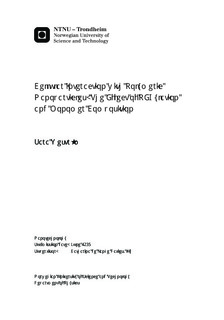Cellular Interaction with Polymeric Nanoparticles: The Effect of PEGylation and Monomer Composition
Master thesis
Permanent lenke
http://hdl.handle.net/11250/247042Utgivelsesdato
2013Metadata
Vis full innførselSamlinger
- Institutt for fysikk [2695]
Sammendrag
It is of importance to understand which nanoparticle properties that govern the interactions between particles and cells, in order to develop a nanocarrier with the desired functionality. In this thesis, nanoparticles made of biodegradable poly(alkyl cyanoacrylate), with either butyl or octyl as the side chain, and with different polyethylene glycol (PEG) surface coatings, have been utilized. The objective was to determine whether variations in these properties influenced cellular uptake and toxicity in prostatic adenocarcinoma cells, as well as the release of a model drug, nile red.Cellular uptake of nanoparticles was investigated in vitro using flow cytometry and confocal laser scanning microscopy. It was established that the encapsulated nile red marker could dissociate from the particles, thus making evaluation of cellular uptake difficult. No alterations in PEG type or chain lengths made nile red remain in the particles to such a degree that endocytosis of nanoparticles could be detected. Spectrophotometric analyses of nile red release from the nanoparticles and into cell medium demonstrated that around 45% or more of originally encapsulated nile red was released after 3 hours. This confirmed high nile red release from the particles, and at the same time it showed that changes in PEGylation did not reduce the release to any extent. After estimating PEG chain surface densities, it was evident that all particles had very low PEG densities, providing an explanation to why nile red dissociated from the particles to such a high degree: the PEG layer did not shield a large enough part of the particle surface area to effectively hinder release of nile red.Cytotoxicity after nanoparticle exposure was determined using an assay measuring the metabolic activity of cells. Toxicity was found to be strongly dependent on the length of the alkyl side chain in the monomer, where the longest chain, with the lowest degradation rate, was the least toxic. Altogether, this suggests toxicity induced by release of degradation products, but it can also be attributed to residual surfactant from the synthesis, as the observed cytotoxicity was higher than what is reported in literature for similar nanoparticles.
